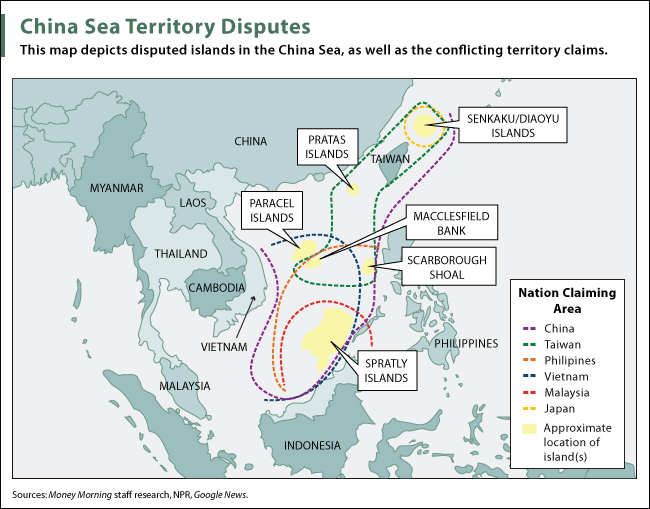For over four years now, Money Morning Executive Editor William Patalon, III, has been keeping investors "in the know" about escalating tensions in the South China Sea. Always quick to research profit opportunities linked to the conflict, Patalon routinely reports back to his readers news of the latest defense and tech plays involved.
But now we've learned of another threat that's fomenting about 1,200 miles to the northeast in the East China Sea.
The impending battle over this region could result in a World War III...

How the Battle Over the East China Sea Could Lead to World War 3
Just south of Okinawa, Japan, sits an archipelago of eight uninhabited land masses - the Senkaku Islands to the Japanese, or the Diaoyu Islands to the Chinese. Since these islands sit north of Taiwan, they are considered a part of the East China Sea region (though, sometimes, the archipelago is mentioned in the South China Sea dispute, because it belongs to the overall South Pacific region to which China has made various territorial claims).
On Feb. 3, Japanese Prime Minister Shinzo Abe announced Japan would begin building military settlements on these islands, as they are the rightful property of his country.
Don't Miss: The Secret That Can Turn $2,500 into $1 Million or More
China immediately disagreed. It claimed the islands belong to Beijing -- and have ever since the end of WWII.
Then the United States weighed in:
"I made clear that our longstanding policy [in support of Japan' s claim to] the Senkaku Islands stands," U.S. Defense Secretary James Mattis announced in a Feb. 4 press conference with Japanese Defense Minister Tomomi Inada.
In a flash, China issued an ominous warning to Washington over Mattis' words...
[mmpazkzone name="in-story" network="9794" site="307044" id="137008" type="4"]
"We urge the U.S. side to adopt a responsible attitude and stop making wrong remarks on the issue of the sovereignty of Diaoyu Islands," Chinese Foreign Ministry spokesman Lu Kang said that same day, according to CNN.
Lu also claimed the United States "brought instability to the region."
But one look at China's military behavior in the East China Sea over the past year shows that a lot of "instability" comes directly from Beijing...
In fact, since April 2016, there's been a 100% increase in Chinese military aircraft intercepts over the Senkaku Islands.
Just today, CNBC reported that Japan now scrambles its jets to counter Beijing fighter aircraft on average about twice per day. When fighter jets "scramble," they maneuver alongside an enemy aircraft in order to take photos, make contact with the crew on board, or to escort the intruder out of their airspace. A year ago, Japanese fighter jets scrambled against Beijing's only once per day. In response to Beijing's militant uptick, Tokyo has doubled its own fighter jet cache at its Okinawa Naha Air Base. It now boasts a total of about 40 fighter jets altogether.
But one slip up - one accident midair, one misunderstanding - could easily lead to WWIII.
The U.S. - with its navy already posted in the East China Sea - would likely defend Japan.
And other nations would find themselves looped into the ensuing conflict as well, especially those that already have stakes in the greater Pacific territory, like North Korea, South Korea, Taiwan, the Philippines, and even Russia.
Up Next
China thinks it can push the United States and its allies out of Asia altogether to secure its energy riches for itself.
Thanks to a small $6 U.S. defense contractor with top-secret technology, the Pentagon has a plan to stop China dead in its tracks. Click here for the full briefing.
Follow Money Morning on Twitter @moneymorning, Facebook, and LinkedIn.
Related Articles:
- Money Morning: The U.S. Navy Just Ramped Up Aggression in the South China Sea
- Money Morning: The Pentagon Won't Tell You How Dangerous North Korea Is - but Trump Will
- Money Morning: 10 Times We Narrowly Avoided World War 3


